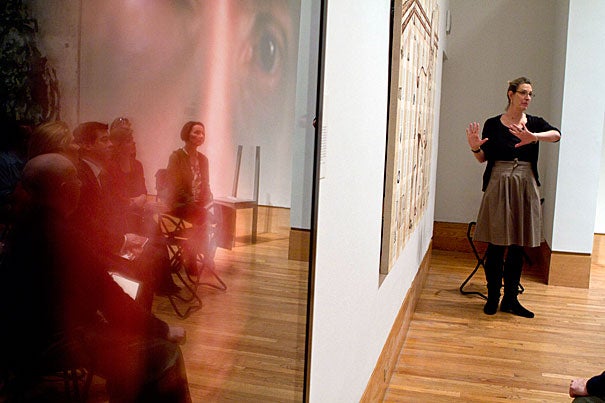
Corinne Zimmerman, a senior museum educator at the Harvard Art Museums, addresses a group of Harvard Business School administrators on how to develop communication skills. Zimmerman used a piece of art by Tim Rollins and K.O.S called “Animal Farm: P.W. Botha 1” (right) to outline the discussion. Another piece by Gary Schneider titled “Helen” by reflects the audience.
Meghan Dhaliwal/Harvard Staff Photographer
An artful perspective
Museum educators help Harvard community explore leadership
In Harvard Business School’s (HBS) popular elective course “The Moral Leader,” students use great literature to explore ethical decision-making and leadership.
Writings as diverse as “A Man for All Seasons,” the play about Sir Thomas More, the adviser to King Henry VIII who refused to accept him as head of the Church of England, and the autobiography of Katharine Graham, the publisher of the Washington Post during the Watergate scandal, help students to understand the reasoning behind difficult ethical choices.
They also study abstract artist Jackson Pollock.
In collaboration with Harvard Art Museums’ education department, the students rove the Harvard Art Museums/Arthur M. Sackler Museum’s galleries during a workshop for the course, observing, discussing, and writing about the work they encounter, like a provocative piece by Pollock or a somber self-portrait by German painter Max Beckmann.
“It’s a method to help people to distance themselves from their immediate moral judgments and allow them to truly engage with the context that they need,” said M.B.A. Class of 1966 Professor of Management Practice Sandra Sucher, who teaches the HBS class in the fall.
Like the literature, the pictures, paintings, and sculptures help students to tap into a different way of conceptualizing leadership. The process of examining an abstract work of art together, then discussing reactions and interpretations, acts as a powerful pedagogical tool, said Sucher, since a core skill for future leaders is the ability to listen carefully to other points of view.
“You can never really assume what you are thinking about a given situation is exactly what someone else is … and if you can’t see the differences among other people, there is no way you can lead them.”
For Ray Williams, former museum director of education, using art collections to help students learn is a vital part of any University’s teaching mission. He developed the collaborative program to help Harvard-affiliated groups look with an artistic lens at a range of issues. Building on Williams’ work, the museum’s education staff consults with professors and educators to create tailored workshops that reflect the goals of their particular course.
“Our job as museum educators is to try to design learning experiences that make sense in this environment, that draw on the museum’s special qualities as an environment for teaching and learning, and help people make connections with works of art,” said Corinne Zimmermann, senior museum educator.
The department’s work extends well beyond the business community. In 2009 it created a program that helps immigrants to enjoy Harvard’s collections, develop their English skills, and connect to important lessons in history and democracy. It also works closely with local medical professionals, using art to explore areas like compassion and the challenges of communicating with patients.
Ricardo Wellisch, a physician in internal medicine and instructor in medicine at Harvard Medical School, has long been interested in how to teach young doctors, lost in the daily crush of information overload, the concept of empathy. He turned to the education department for help in conceiving a workshop at the museum that would use art “as the vehicle that helps residents talk a little bit more freely.”
Six to 10 times a year, he brings his current group of third-year residents to the museum. where they “let their guard down and speak about things that they feel, not just what they know.”
In one gallery, an ancient Greek funeral stone carved with the figure of a little girl prompts emotional discussions about mortality. Residents use the work as a springboard to talk about their own experiences, like telling a patient he has cancer, or delivering the news that a chemotherapy treatment isn’t working.
“Just stopping to think about things that we experience every day really makes you see the experience at a deeper level,” said chief resident Laila Khalid. “This reflection together reminds you of your humanity.”
On a recent afternoon, about 20 HBS administrators took part in the program to explore issues of leadership and creativity. During the session, they broke into smaller groups and fanned out across the gallery to examine and discuss various pieces on display.
Ann Cichon, managing director, Division of Research and Faculty Development at HBS, and her group decided on an unsettling sculpture by the American artist Robert Gober. His work “Untitled” depicts an eerie sink made of plaster, beeswax, human hair, cotton, leather, aluminum pull-tabs, and enamel paint. The viewer’s gaze is drawn, not by the sink, but by the curving legs topped by a child’s blue socks and white sandals that emanate from its drain and faucets. In analyzing the sculpture and trying to understand the artist’s perspective, Cichon and her group made a connection to their own work.
“We realized we were wrestling to figure it out, just like we do in our own jobs.”




